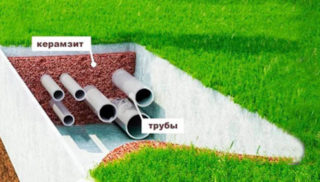The sewerage system, mounted in accordance with SNiP, observing the slopes, the depth of the location below the freezing zone of the earth and the installation rules, will work flawlessly. But it is not always possible to fulfill the prescribed instructions, therefore the pipelines are insulated with the help of special materials. They reduce heat transfer between the polluted environment and the ground, thereby preventing freezing.
When sewer pipes need insulation
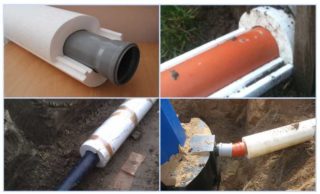
If the outside air temperature drops below 0 degrees, the drainage system must be insulated even in unheated rooms. The question is in choosing the right materials. At the same time, attention is paid to the manufacturer's trademark.
To avoid additional costs for insulating pipes, they are laid below the level of soil freezing, information can be found in reference books. In the permafrost zone and in the northern regions, it is necessary to use active insulation using heating cables that are wrapped around the pipeline.
Sewer pipes in a private house do not need to be insulated due to the following factors:
- The drainage system is built on the principle of gravity, drains do not fill the entire internal volume and do not stand in them, as it happens in water pipes. Due to the slope, all drains after the work of plumbing fixtures enter the septic tank without stagnating inside the pipeline.
- The minimum tap water temperature is 3-5 degrees. For the formation of a crystalline structure of ice, static water molecules or abnormal weather conditions are required.
- When wastewater is discharged into the aeration station, the purification process occurs with the release of heat. Through the condensation pipe, warm gases are discharged towards the fan riser located in the house.
However, all of the above is leveled by improper installation in violation of SNiP. The system freezes if the pipe has stagnation zones where ice is formed as a result of failure to comply with the required slope, or if the pipeline was laid without a sand cushion and backfill. As a result, due to the expansion of the freezing soil, the pipe "walks" with the formation of the same stagnation zones or subsides as a result of improper compaction of sand.
Types of insulation for sewer pipes
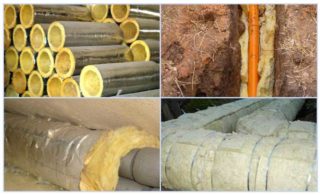
Most often, the following materials act as passive insulation:
- mineral wool;
- glass wool;
- slag;
- expanded clay;
- expanded polystyrene or polystyrene;
- polyurethane foam;
- foamed polyethylene.
Mineral or stone wool is a fibrous material that is obtained by heating rocks to a melting point of 1500 degrees. The resulting mass, reminiscent of lava, goes to centrifuges, where stone threads are drawn with the help of air flows and filters.
Fiberglass is made from quartz, sand, or recycled materials. Broken glass is melted and passed through microscopic holes. The resulting glass filaments are wound on spools, then treated with a sizing agent, as a result of which the material becomes waterproof and abrasion resistant. Glass wool has good thermal insulation properties, flexibility and strength. Heat loss decreases with increasing fiber thickness.
Slag wool is obtained from liquid blast-furnace slags, which are blown through using streams of steam or air.All of the listed fiber insulation materials have different thread thicknesses, thermal insulation properties and moisture resistance. The material belongs to non-combustible compounds, at a temperature of 250-300 degrees it loses its thermal insulation properties, and the formaldehydes contained in it reduce the scope of its application.
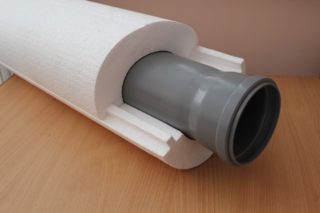
Foam insulation consists of polystyrene granules (2%) and air (98%). The particle size is 1-5 mm. With the help of a gas generator, the elements are glued together, then a shell is formed under the press, which can be used repeatedly. The thermal conductivity properties are almost the same as those of mineral wool.
Polyurethane foam has a density and strength higher than that of polystyrene with the same thermal conductivity. The material is better preserved during operation and can withstand temperatures from -180 to +130 degrees.
Foamed polyethylene or energy flex has a low thermal conductivity of 0.05 and takes up little space, therefore it is used in small gaps between the pipeline and the wall. Insulation works in the range from -50 to +90 degrees. Produced in the form of cylinders and rolls, as well as one- or two-sided foil products. It is most often used in basements and unheated structures for internal sewerage and floor insulation.
Expanded clay is a free-flowing material that retains its insulating properties only in a dry state.
Penoplex or extruded polystyrene foam is produced in the form of segments of different thicknesses and has a low cost.
Selection recommendations
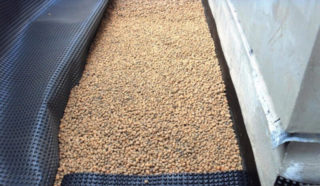
There are several criteria that the selected insulation materials for the external sewage pipeline must meet:
- low coefficient of thermal conductivity;
- providing reliable waterproofing;
- durability;
- resistance to temperature extremes and aggressive chemical compounds;
- easy installation;
- high fire-fighting properties.
If the heaters meet these conditions, they stop at the cheapest option.
Insulation installation
Fiber insulation installation technology:
- Wrap the sewer pipes in a spiral with aluminum foil tape, aligning the joints so that there are no missing areas. This material has good heat and moisture insulating properties.
- The thermal insulation material is fixed with sanitary tape.
- For waterproofing, roofing material or adhesive tape based on aluminum foil is used.
The ends need additional protection against moisture penetration.
Polystyrene insulation installation technology:
- The pipes are wrapped in shells in the form of segments so that the grooves coincide, they are shifted along their length by 20 or 30 cm (overlap) so as not to miss uninsulated sections. No special qualifications are required to perform the work.
- The shells are squeezed and the joints are fastened with tape. It is not recommended to apply glue, as the possibility of reuse after repair is lost.
Polystyrene insulation is used with a pipe diameter of 17 mm to 1200 mm. For pipes with a large cross-section, up to 8 insulation segments are used.
- line the trench with two layers of membrane;
- pour expanded clay;
- cover the heat-insulating material with overlapping panels to isolate it from water.
This type of insulation can only be installed in dry weather.
Insulation cost
Expanded polystyrene with a thickness of 50 mm is supplied for pipes with different diameters, therefore the cost of the products varies. The price of an insulating shell for sewer pipes with a diameter of 110 mm is 175 rubles / m2; D57 * 50 for 125 rubles / l.m .; D160 * 50 for 230 rubles / r.m.
The durability of expanded polystyrene is 40 years. The material does not require an additional insulating coating.
Semi-cylinders made of mineral wool with a length of 1000 mm and a thickness of 20 mm have different costs depending on the diameter: from 40 to 266 rubles / l.m .; with a thickness of 30 mm - from 81 to 611 rubles / l.m .; with a thickness of 40 mm - from 109 to 705 rubles / l.m.
Packing of polyethylene pipes 30 lm with a diameter of 110/9 mm with a length of products of 2 m each costs 110 rubles.


